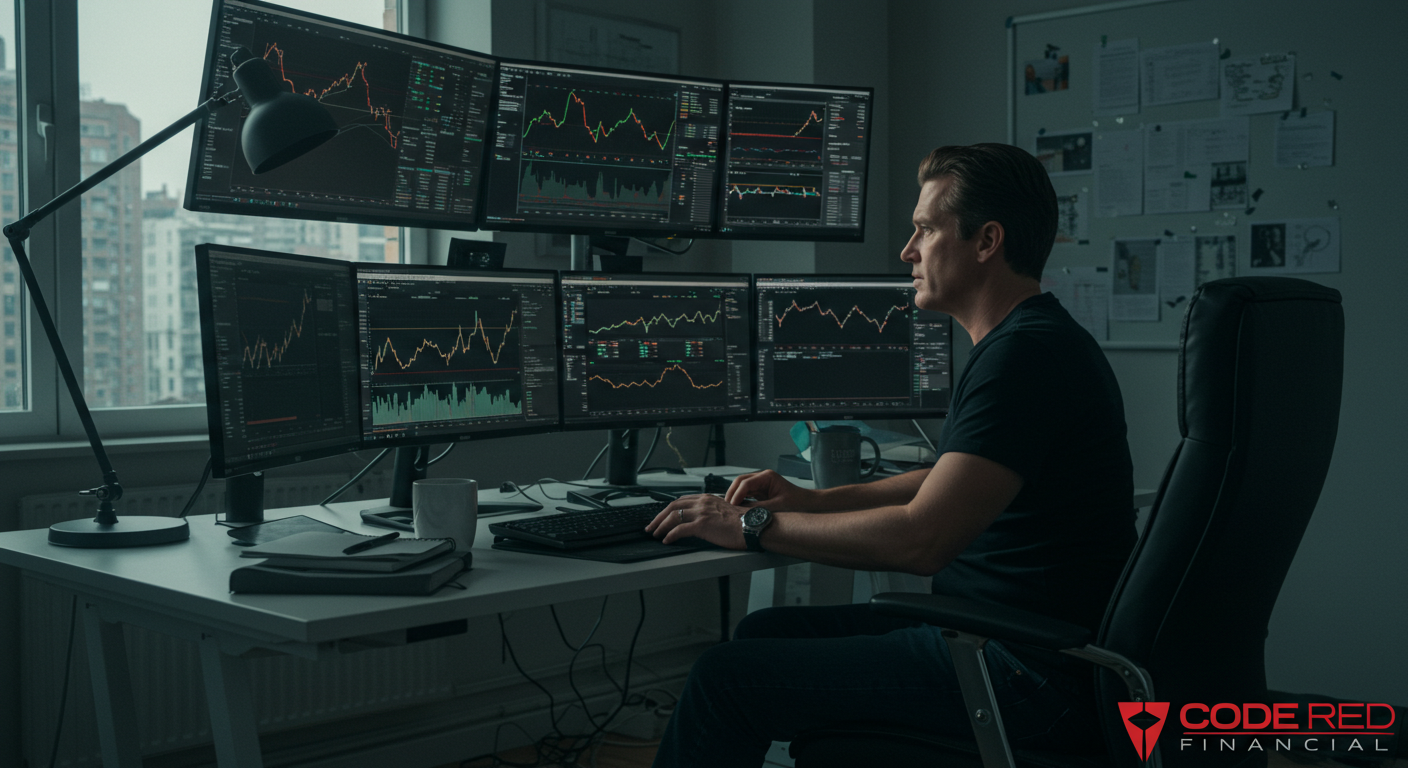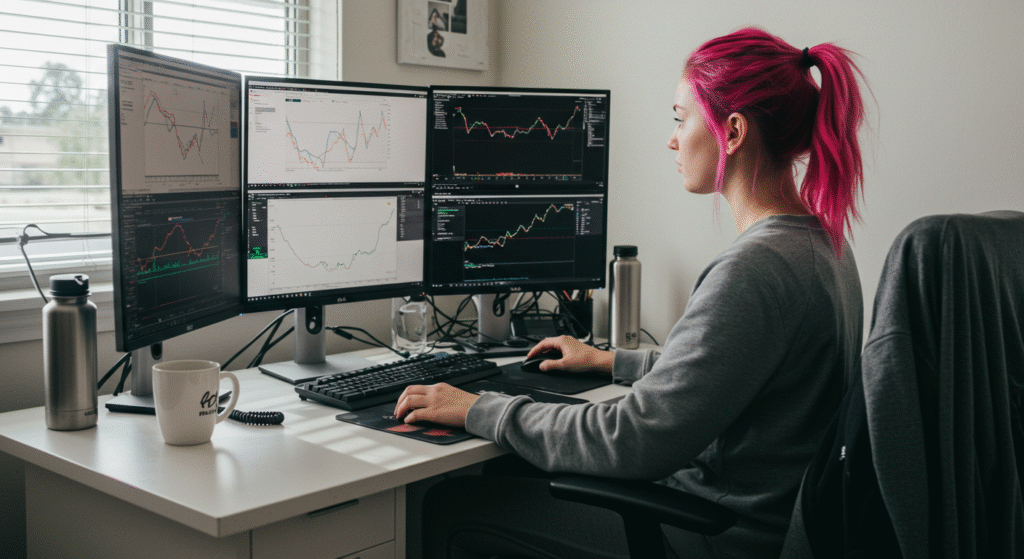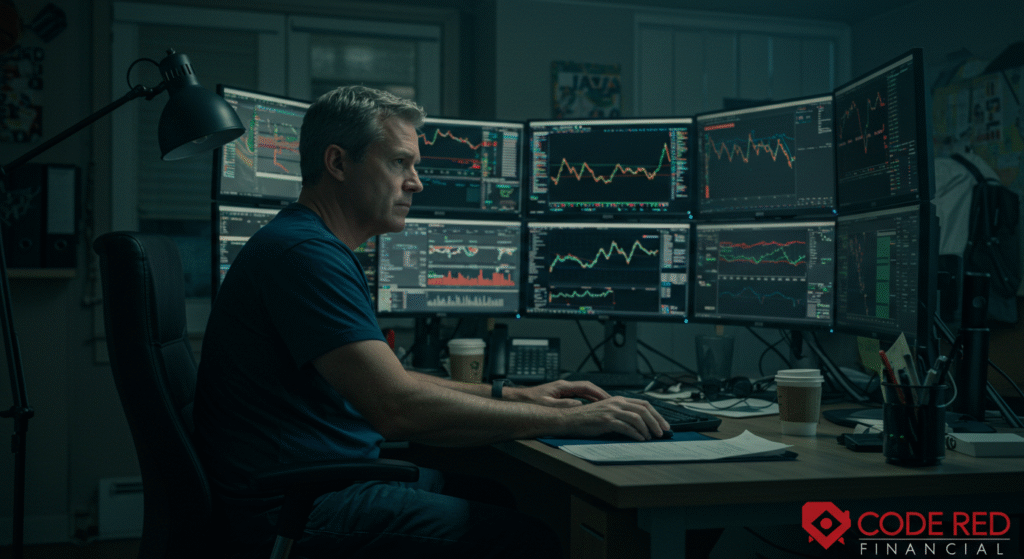
My Routine
I remember what first drew me to day trading. It was that captivating image – the idea of being my own boss, making smart moves, and achieving financial freedom from a cool home office, just me and the glowing charts. The dream of escaping the 9-to-5, of being the master of my own financial destiny. That picture is powerful, almost magnetic. But after years in the trenches, I can tell you that while the allure has a kernel of truth, the reality is a far more complex, demanding, and, yes, rewarding tapestry woven with threads of intense discipline, relentless analysis, and a level of emotional fortitude I hadn’t fully fathomed at the start.
So, what does a day actually look like for someone like me, a full-time day trader? Forget those flashy images of easy money and perpetual vacations. Let me walk you through my typical day. It’s not just about watching numbers flicker; it’s about running a one-person business where I’m the CEO, the analyst, the risk manager, the psychologist, and sometimes even the IT guy. This is my reality.
The Pre-Market Ritual: My Calm Before the Storm (4:30 AM – 9:00 AM EST)
Long before the opening bell even whispers on Wall Street, my day is in full gear. My alarm goes off at 4:30 AM (Truthfully, I never used an alarm). It’s not a reluctant drag out of bed; it’s a conscious choice. These early hours are absolutely golden for laying the groundwork for what I hope will be a successful trading day. My mind needs to be sharp, and the market waits for no one.
My routine starts with me, not the markets. A quick workout or a quiet meditation session helps me clear my head and steel myself for the emotional currents I know the day might bring. Then, a healthy breakfast – I need sustained energy, not a sugar crash. This personal discipline is a direct reflection of the discipline I need when I’m actually trading.
By 6:00 AM, I’m settled at my command center – my multi-monitor setup. The screens spring to life, painting a picture of charts, news feeds, and my trading platforms. This is where my pre-market grind truly begins:
- Global Market Pulse Check: First things first, I need to see what happened while I was asleep. How did the Asian and European markets fare? What are the U.S. index futures (S&P 500, Nasdaq, Dow) hinting at for our open? Global movements can set the tone, and I need to understand that sentiment.
- Economic Calendar – My Crystal Ball (Sort Of): Is there a jobs report today? Inflation data? A Fed announcement? I meticulously scan the economic calendar. These high-impact events can inject serious volatility, creating both opportunities I might want to seize or risks I need to sidestep. Knowing when they hit and what the market expects is crucial for my planning.
- Sifting Through the News: I dive into financial news websites, industry-specific reports, and even gauge credible social media sentiment (with a healthy dose of skepticism, of course). Are there major earnings releases? News of mergers, acquisitions? Analyst upgrades or downgrades that could make certain stocks “in play”? Geopolitical shifts? All this information helps me identify potential movers.
- Crafting My Watchlist: Based on all this and aligned with my specific trading strategies (I might be looking for gappers, momentum plays, or mean reversion setups), I curate a focused watchlist. This isn’t just a random list of tickers; these are stocks or assets that fit my predefined criteria for a potential trade. I’ll note key support and resistance levels, potential catalysts, and typical trading volumes.
- Technical Deep Dive: For every instrument on my watchlist, I get granular with technical analysis. I’m looking at price patterns, trend lines, support and resistance zones, moving averages, and indicators like RSI or MACD. This helps me pinpoint potential entry and exit points – my battle plan for each potential engagement.
- My Daily Trading Blueprint: This is vital. I never go into the market “just to see what happens.” I outline the specific trade setups I’m looking for, my maximum risk per trade (for me, it’s typically a small percentage of my trading capital), my profit targets, and my non-negotiable stop-loss levels. I also mentally walk through different scenarios: what if the market opens strong? Weak? Choppy? Having this plan helps me keep my emotions in check when the pressure is on.
- Systems Go: Finally, I double-check everything. Are my trading platforms running smoothly? Is my internet connection solid? All my tools functioning? A technical hiccup at a critical moment is a nightmare I try to avoid.
By 9:00 AM, I’ve already invested several hours of intense, focused work. I feel prepared, centered, and I have a clear roadmap. The myth of “easy money” has already been thoroughly debunked by the sheer effort of this preparation.

The Market Open: My Rush Hour (9:30 AM – 11:00 AM EST)
The 9:30 AM EST opening bell isn’t just a sound; it’s a starting gun. For me, those first 30 to 90 minutes are often the most electric part of the day. This is when volatility tends to be highest, offering the biggest price swings and, if I’ve done my homework, some of my best opportunities. It’s also the most treacherous time if I’m not on my A-game.
I strive for an outward appearance of calm focus, but internally, all my senses are heightened.
- Executing My Plan: I watch my shortlisted stocks like a hawk. If a stock behaves exactly as my pre-market analysis suggested – say, it breaks a key resistance level with convincing volume – I execute my trade. Swiftly. Decisively. Entry order, stop-loss order, and sometimes even my initial take-profit order are placed almost in the same breath.
- Managing My Babies (The Initial Positions): Trades are rarely instant gratification. The market has its own rhythm. I monitor my open positions closely, making sure they’re acting as anticipated. If a trade immediately sours and hits my pre-set stop-loss, I take that small loss. No arguments, no hoping it’ll turn around. Emotional attachment is a trader’s poison.
- Scanning for Emergent Plays: While I’m managing my current trades, I’m also keeping an eye out for new setups that might pop up in the opening flurry. The market is dynamic; sometimes unexpected gems appear. But even these are filtered through my established criteria – no impulsive “FOMO” (Fear Of Missing Out) trades. That’s a lesson I learned the hard way.
- Riding the Emotional Waves: This is where my mental game is truly tested. A quick win can feel amazing, a sudden loss can be frustrating or spark anxiety. I consciously work to stay level. I know that trading on emotion – whether it’s revenge trading after a loss or getting sloppy due to overconfidence after a win – only leads to more mistakes.
That opening hour is a whirlwind. It demands lightning-fast decisions, precise execution, and an almost religious adherence to my trading plan and risk rules. It’s exhilarating, no doubt, but also incredibly mentally taxing.
Mid-Market: The Grind (11:00 AM – 2:30 PM EST)
After that initial adrenaline surge, the market often settles. Volume tends to thin out, and price action can become a bit directionless, sometimes choppy. I call this the “midday grind.” For me, this period requires a tactical shift.
- Patience, Patience, Patience: I’ve learned that trying to force trades when the market is quiet is a common pitfall. If high-probability setups aren’t clearly presenting themselves according to my plan, I’m perfectly okay with sitting on my hands. “No trade” is a valid and often very smart trading decision. I might use this time to review my morning performance, refine some analysis, or simply step away from the screens for a short break to clear my head.
- Nursing My Positions: If I’m still holding trades from the morning, I continue to manage them. This might involve adjusting my stop-losses to lock in some profit (I love a good trailing stop) or taking partial profits if a position reaches one of my targets.
- Seeking Specific Setups: Some of my strategies are actually better suited to these quieter market conditions. I might look for range-bound plays or patterns that hint at a potential afternoon breakout. The intensity might be lower, but my focus remains sharp.
- Fighting the Urge to Overtrade: The temptation to “just do something” can be surprisingly strong, especially if my morning wasn’t spectacular. I have to consciously resist this. Overtrading, particularly in less-than-ideal conditions, usually just racks up small losses and commission costs.
- Always a Student: I might use some of this slower time to read insightful market commentary, revisit educational materials, or dig into my own performance stats. The market is a relentless teacher, and I believe successful traders are students for life.
The mid-market session is less about quick sprints and more about a marathoner’s steady pace. It’s about discipline, unwavering patience, and waiting for the right pitches, rather than swinging at everything.
The Market Close: Winding Down or Ramping Up? (2:30 PM – 4:00 PM EST)
The final 60 to 90 minutes of the trading day often bring another burst of activity. This is partly because institutional players are adjusting their books before the close, and other day traders like me are either looking for a final quick move or, more importantly, ensuring all our intraday positions are closed out.
- Mission: Flat by the Bell: My primary goal as a day trader is to have no open positions when that closing bell rings. Holding trades overnight exposes me to risks I can’t manage while the market is closed – surprise news, overnight gaps, etc. So, I systematically close out anything I’m still holding, whether it’s for a profit, a loss, or at breakeven, all according to my plan.
- Navigating Late-Day Swings: The close can sometimes offer quick scalping opportunities, but it can also be very erratic. I approach it with caution, sticking to setups that have a high probability of working out in the short time remaining and being very mindful that the clock is ticking.
- Quick Mental Recap: Even before the bell, I’m starting to mentally tally the day. How did I do? What were the key trades? Any immediate lessons learned?
At 4:00 PM EST, the closing bell sounds. For many folks, their workday is done. For me, there’s still critical work ahead.
Post-Market Analysis & Gearing Up for Tomorrow: My Work Doesn’t End at the Bell (4:00 PM – 6:00 PM EST or later)
My screens don’t just go dark and stay that way. This post-market period is absolutely vital for me. It’s where I review, learn, and start laying the foundation for the next trading day.
- My Trade Journal – The Unvarnished Truth: I meticulously record every single trade I took. And I mean everything – not just the entry and exit price. I note my rationale for taking the trade, the specific setup, the market conditions at that moment, how I was feeling emotionally before, during, and after the trade, and what went right or wrong. This journal is my most valuable learning tool. It helps me see patterns in my own behavior (both the good and the bad) and refine my strategies.
- Performance Deep Dive: I calculate my net profit or loss for the day. But honestly, what’s more important to me is analyzing how I performed against my trading plan. Did I follow my rules? Did I stick to my risk management? Were my losses within my predefined limits? Did I cut my losing trades quickly as planned? Did I let my winners run (when that was the strategy)? The profit is an outcome; my focus is on the integrity of my process.
- Extracting the Lessons: Every single trading day teaches me something. Maybe I hesitated and missed a great opportunity, or perhaps I jumped the gun on a trade. I dissect these moments to understand why it happened and think about how I can improve.
- Tweaking My Blueprint: Based on what I learned today, I might make small adjustments to my trading plan or my criteria for watchlist selection. The market is always changing, and my strategies have to be agile enough to adapt.
- A Glimpse into Tomorrow: I might do a quick scan of after-hours news or any early indicators for the next trading session. This just plants some seeds for my more in-depth analysis in the morning.
This post-market routine is sacred to me. It’s like a sports team reviewing game footage. Without this critical self-assessment, I know my growth as a trader would stall.
The “Life” Part of My Day Trader’s Life: Beyond the Charts
That image of a day trader lounging by the pool, working just a couple of hours? Mostly a fantasy. While day trading does offer a unique kind of flexibility, it’s anything but a part-time endeavor if you’re serious about making a consistent living.
- Flexibility with a Caveat – Structure: Yes, I am my own boss. Technically, I can take a day off whenever I choose. But I’ve found that inconsistent effort leads to inconsistent results. Most successful traders I know maintain a very structured routine. The “freedom” I have comes hand-in-hand with the immense responsibility of self-discipline.
- The Isolation Factor: Trading can be a solitary pursuit. It’s just me and my screens for many hours each day. To counter this, I actively participate in a few online trading communities, occasionally attend industry meetups, and have a small network of trusted fellow traders I can bounce ideas off of or just vent to.
- Guarding My Mental Capital: The constant exposure to risk, the potential for financial setbacks, and the intense concentration required can really take a toll on my mental well-being. Managing stress is not a luxury; it’s a necessity. For me, that means regular exercise, engaging in hobbies completely unrelated to trading, practicing mindfulness, and leaning on my support system. Burnout is a very real threat in this profession.
- My Financial Reality: My income can be, and often is, erratic. Some months are fantastic, others might be flat, and yes, some result in losses. A huge part of being a successful trader is being a good financial planner. I set aside money for taxes (which are a bit more complicated for traders), maintain a cash buffer for those leaner periods, and manage my trading capital with extreme prudence. It’s not just about making money; it’s about keeping it and growing it wisely over the long haul.
- The Necessity of “Off-Screen” Life: I make a deliberate effort to disconnect, ensuring that trading does not consume my entire identity. Spending meaningful time with family, indulging my passion for particle and astrophysics, honing my martial arts skills, and constantly seeking knowledge all contribute to a well-rounded life beyond the markets. Maintaining this balance not only keeps me sane but also provides the perspective necessary to navigate the highs and lows of trading with a clear mind.

My Unvarnished Truths About Being a Trader
If you take away only one thing from my day, let it be this: succeeding as a day trader is built on a foundation of often unglamorous, hard work and some core principles I live by:
- Discipline is My Co-Pilot: More than any single fancy strategy or indicator, discipline is the bedrock of my trading. It’s the discipline to prepare meticulously, to follow my plan even when it’s uncomfortable, to cut losses without hesitation, to manage my risk on every single trade, and to never stop learning.
- Emotional Resilience – My Shield: Losses are an unavoidable part of this game. My ability to handle these losses constructively, without letting them send me on an emotional tilt or derail my entire strategy, is what I believe separates traders who last from those who don’t.
- Constant Learning – My Compass: Markets evolve. Strategies that were killer yesterday might be duds tomorrow. I’m committed to being a lifelong student and adapting as needed.
- Risk Management – My Lifeline: Protecting my trading capital is always, always priority number one. Without capital, I can’t trade. My strict risk management rules aren’t optional; they are what keep me in the game.
- This is My Business, Not a Casino Trip: I approach day trading with the professionalism it demands. It involves meticulous planning, detailed record-keeping, ongoing performance analysis, and careful capital management – just like any other serious business I might run. Treating it like a hobby or a slot machine is the fastest way I know to empty an account.
- Facing the Failure Rate: It’s a tough pill to swallow, but a large percentage of people who try day trading don’t make it in the long run. I believe this is often because they underestimate these realities, come in with insufficient capital or education, harbor unrealistic get-rich-quick expectations, or simply fail to implement the ironclad discipline and risk management required.
Is Day Trading Right for You? My Word of Caution and Encouragement
Reading about my day might sound pretty intense, and honestly, it should. Day trading isn’t a fit for everyone. Before you start dreaming of quitting your day job, I’d urge you to ask yourself some very honest questions:
- Are you genuinely self-disciplined? Can you create a plan and stick to it, even when your emotions are screaming at you to do something else?
- How do you handle financial losses and emotional setbacks? Can you recover without becoming reckless or despondent?
- Are you truly prepared to dedicate significant time – I’m talking months, if not years – to learning, analyzing, and practicing before you even think about risking your hard-earned money?
- Do you have risk capital – money you can genuinely afford to lose without it impacting your ability to pay your mortgage or buy groceries?
- Are you looking for a legitimate path to financial independence that requires skill and hard work, or are you secretly hoping for a “get rich quick” lottery ticket? (Spoiler: this isn’t it.)
If, after really internalizing these demanding realities, this path still resonates deeply with you, then approach it with the utmost respect it deserves. Get educated from credible, experienced sources – not just from flashy social media gurus. Practice, practice, practice on a demo account with simulated money until you can demonstrate consistent application of your strategy and, more importantly, your risk management, over a significant period. When you do go live with real capital, start small, smaller than you think you need to. And if you can, find a mentor or a community of serious traders to learn from.
My Trader’s Journey
A day in my life as a day trader is a continuous cycle of challenge and reward. It’s like being an entrepreneur, a mental athlete, and a financial strategist all rolled into one. It’s a journey that demands far more than just a desire for profit; it requires a profound, ongoing commitment to personal and professional growth. The potential rewards – both financial and the incredible sense of independence – can be truly substantial for those of us who navigate its complexities with skill, unwavering discipline, and a deep respect for the market. But I can assure you, this path isn’t paved with easy clicks. It’s built on relentless preparation, steely emotional control, and the quiet, consistent execution of a craft I’ve spent years honing. The reality of being a trader, my reality, is that success is earned, minute by minute, decision by decision, day by day. And honestly, despite the challenges, I wouldn’t have it any other way.
Feel free to share your own story and the routine you live by.
Disclaimer: This article is for informational purposes only and should not be considered financial or investment advice. Investing in any of the mentioned passive income streams involves risk, and you could lose money. Before making any investment decisions, it is essential to conduct your own thorough research and consider consulting with a qualified financial advisor who can assess your individual financial situation, risk tolerance, and goals. The potential returns discussed are illustrative and not guaranteed. Market conditions, regulations, and other factors can significantly impact the performance of any investment or business venture.





